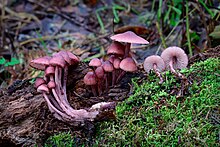| Mycena haematopus | |
|---|---|

| |
| Scientific classification | |
| Domain: | Eukaryota |
| Kingdom: | Fungi |
| Division: | Basidiomycota |
| Class: | Agaricomycetes |
| Order: | Agaricales |
| Family: | Mycenaceae |
| Genus: | Mycena |
| Species: | M. haematopus
|
| Binomial name | |
| Mycena haematopus | |
| Synonyms[1] | |
| Mycena haematopus | |
|---|---|
| Gills on hymenium | |
| Cap is conical or campanulate | |
| Hymenium is adnate | |
| Stipe is bare | |
| Spore print is white | |
| Ecology is saprotrophic | |
| Edibility is not recommended | |
Mycena haematopus, commonly known as the bleeding fairy helmet, the burgundydrop bonnet, or the bleeding Mycena, is a species of fungus in the family Mycenaceae, of the order Agaricales. It is widespread and common in Europe and North America, and has also been collected in old Japan and Venezuela. It is saprotrophic—meaning that it obtains nutrients by consuming decomposing organic matter—and the fruit bodies appear in small groups or clusters on the decaying logs, trunks, and stumps of deciduous trees, particularly beech. The fungus, first described scientifically in 1799, is classified in the section Lactipedes of the genus Mycena, along with other species that produce a milky or colored latex.
The fruit bodies of M. haematopus have caps that are up to 4 cm (1+5⁄8 in) wide, whitish gills, and a thin, fragile reddish-brown stem with thick coarse hairs at the base. They are characterized by their reddish color, the scalloped cap edges, and the dark red latex they "bleed" when cut or broken. Both the fruit bodies and the mycelia are weakly bioluminescent. M. haematopus produces various alkaloid pigments unique to this species. The edibility of the fruit bodies is not known definitively.